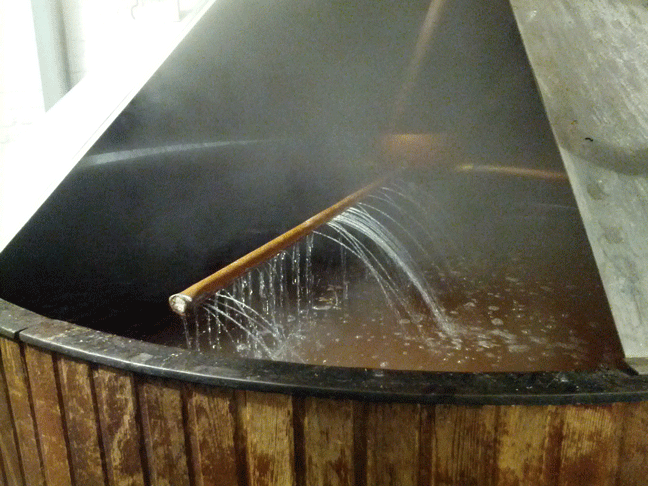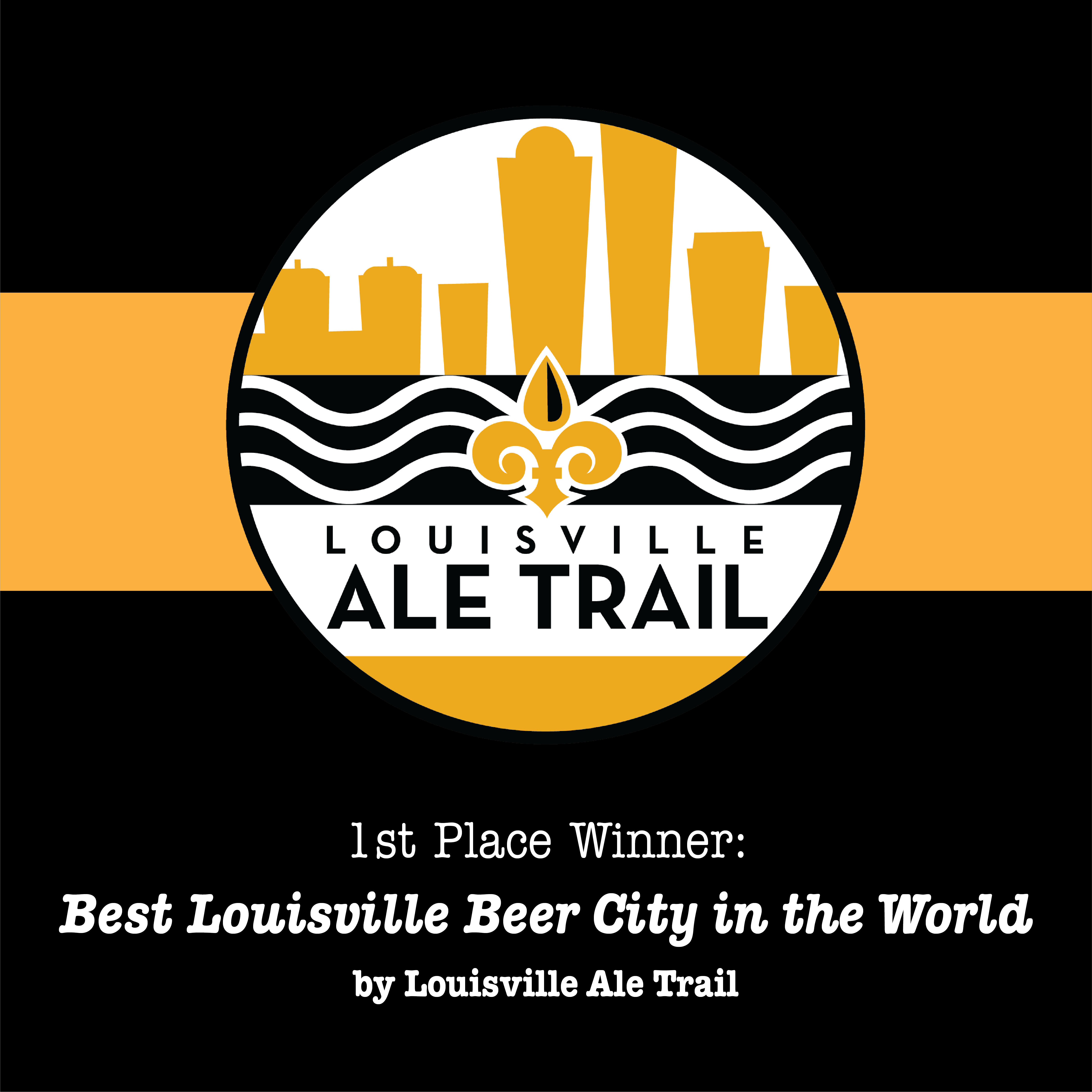The magical, mystical brewery tour: Cantillon
Cantillon’s cheery yellow façade looks out over a vacant lot in an industrial part of Brussels. If you stand quietly on the sidewalk outside and breathe deeply, you can hear the clinking of bottles and smell the pleasant sourness of yeast at work. You might even feel that sharp pleasant sting of anticipation as you imagine taking a sip of a pale-gold gueuze.
Rise and shine, it’s public brew day at Cantillon!
Twice a year, once in the fall at the start of brewing season and once in spring at the end, Cantillon opens its doors to the public. From 6:30am to 3pm the brewers go about their business as curious visitors take guided tours and poke around the mashing, boiling, cooling and bottling rooms where the brewery’s famous lambics are made.
Lambic—the traditional sour beer of Brussels produced via spontaneous fermentation—is pretty magical stuff: complex flavors born of up to 120 strands of wild yeast demand understanding. That’s what I was after one Saturday in November when I crawled out of bed at 6am to grab a taxi for the start of Cantillon’s public brew day.

A lambic a day…
There were already a couple dozen hard-core lambic fans huddled around the croissants and coffee at 7am when I stumbled in. Living in France the last ten years, Cantillon has always been available and not too pricey. I’d been looking forward to visiting the brewery but it wasn’t a once-in-a-lifetime experience—trains run daily between the French and Belgian capitals. For the American friend accompanying me, entering the temple of lambic was obviously a near-religious experience.
After coffee and croissants we cashed in our free drink tickets and started the day with a kriek, the cherry beer made by letting whole Kellery cherries macerate for 5 weeks in 18-month-old lambic, and a gueuze, the result of blending several lambics of different ages and tastes. As we took our last puckery sips, someone called out “English tour now!”. It was time to see the magic first-hand.
A living brewery museum
We started in the mash room where 2 tons of grain and 1000 liters of water were churning in the mashing tun. After 4 hours of this, the wort is pumped upstairs into two copper tanks for a 4-hour boil before being transferred to the copper coolship located in the attic. Later, some very burly, passionate brewers climb inside the mashing tun and shovel out all 2 tons of wet, spent grain by hand, which are donated to a local farmer for cattle feed.
There’s nothing modern about Cantillon, unless you count the bottling line. The rest of the “technology” dates from the brewery’s founding in 1900. Four generations of the Cantillon family have remained true to the brewery’s origins, despite two world wars and several near-bankruptcies.
Where the wild things are
Great clouds of beer fog billowed up from the open mashing tun, leaving condensation on the metal staircase as we headed up to the boiling room. After a brief stop to check out the grain mill, we took a narrow flight of wooden steps to the attic, where the real magic happens.
Huddled with twelve other English-speaking visitors under the brewery’s rafters, we listened to our guide Alberto demystify the rarest of rare beers. “We subcontract everything to nature,” he said, gesturing to the swimming-pool-size copper coolship where the wort passes the night, waiting to be inoculated by wild yeast and fulfill its destiny as a lambic.
We were standing in what is essentially a horizontal cooling tower regulated by hundreds of wooden shingle-levers. The hot wort arriving in the coolship sets off a sucking effect, and the cooler outside air comes rushing through the levers. The coolship allows a maximum surface area of wort to be in contact with cold air and everything eventually settles down to about 18°C. Inoculation by wild yeasts happens throughout the night. The wort is then pumped into oak barrels where it ages for up to three years, until the yeasts have consumed all the sugars.
It’s not a popularity contest
Alberto’s speech was peppered with unapologetic criticism of modern economics and a western predilection for taste-bud corrupting sugar that has left the world incapable of appreciating the finer things in life, i.e. lambics. While I’m not sure I agreed with all his theories, the statistics lean in his favor. Cantillon is all the rage in the States, but a majority of Belgians apparently don’t like this sour beer. The brewery survives thanks to exports to America, which account for half of its production, and the 40,000 plus visitors a year to the brewery-museum—only 7% of them are Belgian.
Beer, naturally
It’s easy to fall under the spell of Brussels’ last remaining brewery, a place where the brewer has a limited control over what happens. “Nature is permanently different…every moment it is ever-changing,” said Alberto. I’ve often heard brewing referred to affectionately as a kind of alchemy, but it was in visiting Cantillon that I really got a sense of this.
Lambics are the oldest style of beer, the way beer was made before humans knew yeast existed, before Louis Pasteur unveiled the mystery of fermentation. Lambics come from a time of magic and mystery, when the brewer was subject to nature and not master of it. Sure, we figured out some tricks along the way, like brewing in winter is better (less bacteria in the air, less risk of contamination) and hops play a preservative role, but ultimately, you were never sure to get the same thing twice.
Cantillon is still subject to nature’s imperative: when the brewery tried to force a longer brewing season last year, they paid the price. Changing temperatures have resulted in an ever-shorter brewing season and they were forced to throw away more than a dozen barrels that became contaminated by bacteria thriving in too-warm conditions. The element of unpredictability gives Cantillon its allure, but it’s also an elegant reminder of the brewer’s role in the whole process.
One for the road
After admiring the coolship and taking a few last deep breaths of that cool, woody yeast-heavy attic air, we headed back down to earth. We finished off our visit with a glass of Fou’Foune, Cantillon’s apricot lambic, named after, well, I’ll let you Google it yourself. Two-hundred grams of hand-pitted fruits go into each liter of this golden elixir; it’s my favorite of the Cantillon brews. We were promised Zwanze as well and were not disappointed: the 2012 rhubarb brew was still available in dusty, emerald-green bottles.
If you have a chance to visit the Cantillon brewery, do. Not only will you experience the magic of one of the world’s rarest beers, you’ll be supporting its continued existence. All the money you’ll save on buying your stock of lambic on-site will surely pay for the round-trip ticket to Brussels.
A final bit of wisdom from the lambics: Le temps ne respecte pas ce qui se fait sans lui,” or “Time does not respect that which is done without it.”
Cantillon Fun Facts
- All organic grains
- 2 tons of grain: 35% raw wheat, 65% malted barley
- 1000L of water: chlorine left to dissipate overnight before using
- Aged, dried hops: at least 3 years old!
- Price of 75cl bottle of kriek at the brewery: 5€
- Price of a glass of gueuze: 2€
Brasserie Cantillon
56 rue Gheude
1070 Brussels
Tel.: +32 2 521.49.28
http://www.cantillon.be
Open Monday to Friday from 9am till 5pm, Saturday from 10am to 5pm. Closed on Sundays and public holidays.
-
Seriously Jealous…. Can’t wait to visit someday
-
Awesome write up! Seriously makes me want to go right now . . .













Comments